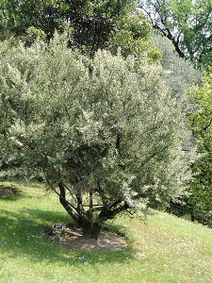Colletia armata
| Colletia armata | |
 | |
| Light: | |
| Moisture: | |
| Hardiness: | 8 |
| Soil pH: | 5.6-8.4 |
| Height: | 11' |
| Width: | 10' |
| Speed: | Slow |
| Blooms: | Early Fall-Early Winter |
| Native to: | |
| Tea: | Yes |
Colletia armata (formerly classified as C. spinosa armata and C. valdiviana) is a very slow growing plant.[1] The form 'Rosea' is stronger-growing.[2]
Propagation: Seed - we have no information for this species but suggest sowing fresh seed as soon as it is ripe in a greenhouse and stored seed as early in the year as it is received. When they are large enough to handle, prick the seedlings out into individual pots and grow them on in the greenhouse for at least their first winter. Plant them out in late spring or early summer, after the last expected frosts.
Cuttings of half-ripe side shoots, 5 - 8cm with a heel, July/August in a frame[3].
Cuttings of mature side shoots of the current year's growth, 10 - 12cm with a heel, early winter in a cold frame. Leave for 18 months before potting up. Good percentage[4].
Cultivation: Grows well in a sandy freely draining loam where it flowers freely in a sunny position[5]. Succeeds in dry soils.[5][2] Plants tolerate partial shade if they are grown in a perfectly draining lean soil[3]. They are very tolerant of maritime exposure[1][3].
A very ornamental plant[6], it is not very hardy in Britain, succeeding outdoors only in the milder areas of the country and tolerating temperatures down to about -5°c[3].
The plants do not have leaves, but they have very sharp spines which are used instead of the leaves in the function of photosynthesis[7].
The flowers are fragrant[7]. They have the scent of vanilla[2].
Range: S. America - S. Chile.
Usage: A very prickly plant and also very tolerant of maritime exposure, it makes a good windbreak hedge and is also good for security. Its main drawback is that it is slow to reach an effective height[1].
Pollinators: Insects
Soil: Can grow in light and medium soils.
Drainage: Prefers well drained soil.
Wind: Tolerates maritime wind exposure
Flower Type: Hermaphrodite
Links
References
- ↑ 1.0 1.1 1.2 Rosewarne Experimental Horticulture Station. Shelter Trees and Hedges. Ministry of Agriculture, Fisheries and Food, 1984.
- ↑ 2.0 2.1 2.2 Davis, Brian. Climbers and Wall Shrubs. Viking, 1990.
- ↑ 3.0 3.1 3.2 3.3 Huxley, Anthony. The New Royal Horticultural Society Dictionary of Gardening. MacMillan Press, 1992.
- ↑ Sheat, Wilfrid. Propagation of Trees, Shrubs and Conifers. St Martin, 1948.
- ↑ 5.0 5.1 Bean, William. Trees and Shrubs Hardy in Great Britain. Murray, 1981.
- ↑ Chittendon, Fred. RHS Dictionary of Plants. Oxford University Press, 1951.
- ↑ 7.0 7.1 Brickell, Christopher. The RHS Gardener's Encyclopedia of Plants and Flowers. Dorling Kindersley Publishers, 1990.